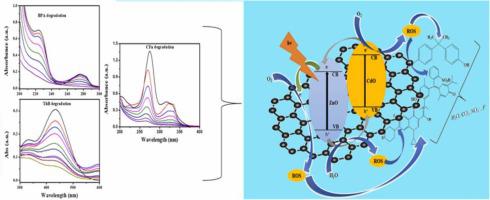Journal of Hazardous Materials ( IF 13.6 ) Pub Date : 2021-09-27 , DOI: 10.1016/j.jhazmat.2021.127332 Sonu Kumar S Kumar 1 , R D Kaushik 1 , L P Purohit 2

|
The widespread existence of different organic contaminants mostly phenolic compounds, organic dyes and antibiotics in water bodies initiated by the various industrial wastes that raised great scientific concern and public awareness as well recently owing to their prospective capability to spread these contaminants resistant gene and pose hazard to human. In the present study, a series of nanostructured ZnO-CdO incorporated with reduced graphene oxide (ZCG nanocomposites) were successfully synthesized by a simple refluxing method and characterized by using the X-ray diffraction (XRD), Raman spectroscopy, FT-IR spectroscopy, photoluminescence spectroscopy, field emission-scanning microscope (FE-SEM) and UV–visible diffused reflectance spectroscopy (DRS) for the photocatalytic degradation of bisphenol A (BPA), thymol blue (ThB) and ciprofloxacin (CFn) with illumination of UV light. The maximum degradation and mineralization of BPA, ThB and CFn was achieved around 98.5%, 98.38% and 99.28% over the ZCG-5 nanocomposite photocatalyst after UV light irradiation for 180 min, 120 min and 75 min, respectively. The superior photocatalytic activity of ZCG-5 ascribed to enhance adsorption capacity, effective separation of charge carriers consequential for the production of more ROS after incorporation of RGO nanosheets with ZnO-CdO in photocatalyst. The conceivable photocatalytic degradation mechanism of BPA, ThB and CFn was elucidated through ROS identification and the assessment of photocatalyst stability by reusability, EEO (kwh/m3order) and UV light dose (mJ/cm2) were evaluated. The plausible photocatalytic degradation pathways were proposed for the degradation of BPA, ThB and CFn via GC-MS analysis. The present work investigates the efficient removal of BPA, ThB and CFn using ZCG nanocomposites as photocatalyst.
中文翻译:

ZnO-CdO 纳米复合材料与氧化石墨烯纳米片相结合用于高效光催化降解双酚 A、百里酚蓝和环丙沙星
各种工业废物引发的水体中广泛存在不同的有机污染物,主要是酚类化合物、有机染料和抗生素,最近也引起了极大的科学关注和公众意识,因为它们具有传播这些污染物抗性基因的预期能力,并对水体造成危害。人类。在本研究中,通过简单的回流方法成功合成了一系列掺入还原氧化石墨烯的纳米结构 ZnO-CdO(ZCG 纳米复合材料),并通过 X 射线衍射(XRD)、拉曼光谱、FT-IR 光谱、光致发光光谱、场发射扫描显微镜 (FE-SEM) 和紫外可见漫反射光谱 (DRS) 用于光催化降解双酚 A (BPA), 百里酚蓝 (ThB) 和环丙沙星 (CFn) 与紫外线照射。在紫外光照射 180 分钟、120 分钟和 75 分钟后,ZCG-5 纳米复合光催化剂分别实现了 BPA、ThB 和 CFn 的最大降解和矿化率约为 98.5%、98.38% 和 99.28%。ZCG-5 优异的光催化活性归因于增强吸附能力,有效分离电荷载流子,从而在将 RGO 纳米片与 ZnO-CdO 结合到光催化剂中后产生更多的 ROS。BPA、ThB 和 CFn 的可想象的光催化降解机理通过 ROS 鉴定和通过可重复使用性、EEO (kwh/m) 评估光催化剂稳定性来阐明 紫外光照射 180 分钟、120 分钟和 75 分钟后,ZCG-5 纳米复合光催化剂的效率分别为 38% 和 99.28%。ZCG-5 优异的光催化活性归因于增强吸附能力,有效分离电荷载流子,从而在将 RGO 纳米片与 ZnO-CdO 结合到光催化剂中后产生更多的 ROS。BPA、ThB 和 CFn 的可想象的光催化降解机理通过 ROS 鉴定和通过可重复使用性、EEO (kwh/m) 评估光催化剂稳定性来阐明 紫外光照射 180 分钟、120 分钟和 75 分钟后,ZCG-5 纳米复合光催化剂的效率分别为 38% 和 99.28%。ZCG-5 优异的光催化活性归因于增强吸附能力,有效分离电荷载流子,从而在将 RGO 纳米片与 ZnO-CdO 结合到光催化剂中后产生更多的 ROS。BPA、ThB 和 CFn 的可想象的光催化降解机理通过 ROS 鉴定和通过可重复使用性、EEO (kwh/m) 评估光催化剂稳定性来阐明 在光催化剂中将 RGO 纳米片与 ZnO-CdO 结合后,有效分离电荷载流子,从而产生更多的 ROS。BPA、ThB 和 CFn 的可想象的光催化降解机理通过 ROS 鉴定和通过可重复使用性、EEO (kwh/m) 评估光催化剂稳定性来阐明 在光催化剂中将 RGO 纳米片与 ZnO-CdO 结合后,有效分离电荷载流子,从而产生更多的 ROS。BPA、ThB 和 CFn 的可想象的光催化降解机理通过 ROS 鉴定和通过可重复使用性、EEO (kwh/m) 评估光催化剂稳定性来阐明3阶)和紫外光剂量(mJ/cm 2)进行了评估。提出了通过 GC-MS 分析降解 BPA、ThB 和 CFn 的合理光催化降解途径。本工作研究了使用 ZCG 纳米复合材料作为光催化剂有效去除 BPA、ThB 和 CFn。



























 京公网安备 11010802027423号
京公网安备 11010802027423号